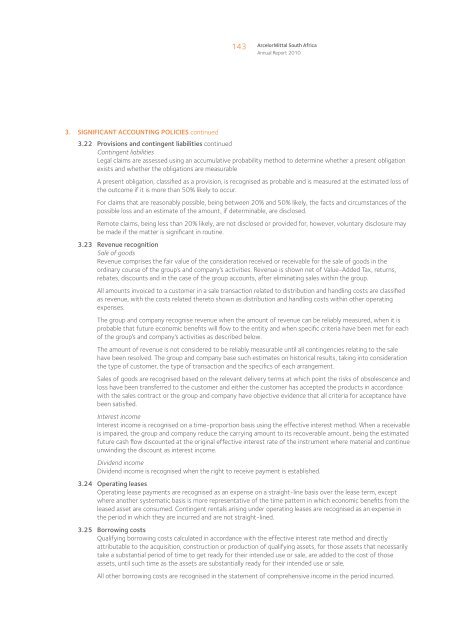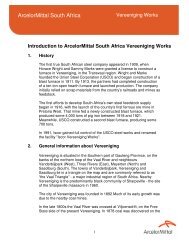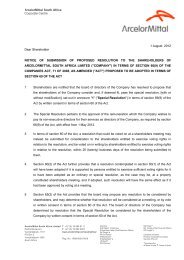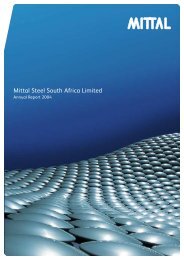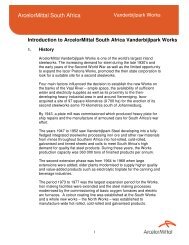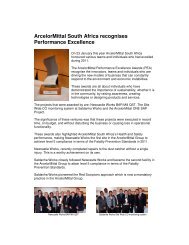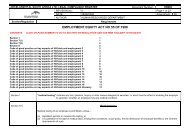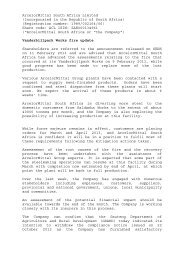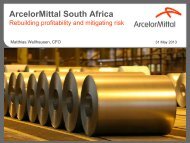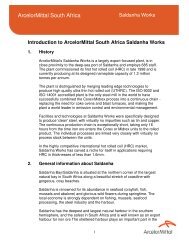bold spirit - ArcelorMittal South Africa
bold spirit - ArcelorMittal South Africa
bold spirit - ArcelorMittal South Africa
Create successful ePaper yourself
Turn your PDF publications into a flip-book with our unique Google optimized e-Paper software.
143<br />
<strong>ArcelorMittal</strong> <strong>South</strong> <strong>Africa</strong><br />
Annual Report 2010<br />
3. SIGNIFICANT ACCOUNTING POLICIES continued<br />
3.22 Provisions and contingent liabilities continued<br />
Contingent liabilities<br />
Legal claims are assessed using an accumulative probability method to determine whether a present obligation<br />
exists and whether the obligations are measurable<br />
A present obligation, classified as a provision, is recognised as probable and is measured at the estimated loss of<br />
the outcome if it is more than 50% likely to occur.<br />
For claims that are reasonably possible, being between 20% and 50% likely, the facts and circumstances of the<br />
possible loss and an estimate of the amount, if determinable, are disclosed.<br />
Remote claims, being less than 20% likely, are not disclosed or provided for, however, voluntary disclosure may<br />
be made if the matter is significant in routine.<br />
3.23 Revenue recognition<br />
Sale of goods<br />
Revenue comprises the fair value of the consideration received or receivable for the sale of goods in the<br />
ordinary course of the group’s and company’s activities. Revenue is shown net of Value-Added Tax, returns,<br />
rebates, discounts and in the case of the group accounts, after eliminating sales within the group.<br />
All amounts invoiced to a customer in a sale transaction related to distribution and handling costs are classified<br />
as revenue, with the costs related thereto shown as distribution and handling costs within other operating<br />
expenses.<br />
The group and company recognise revenue when the amount of revenue can be reliably measured, when it is<br />
probable that future economic benefits will flow to the entity and when specific criteria have been met for each<br />
of the group’s and company’s activities as described below.<br />
The amount of revenue is not considered to be reliably measurable until all contingencies relating to the sale<br />
have been resolved. The group and company base such estimates on historical results, taking into consideration<br />
the type of customer, the type of transaction and the specifics of each arrangement.<br />
Sales of goods are recognised based on the relevant delivery terms at which point the risks of obsolescence and<br />
loss have been transferred to the customer and either the customer has accepted the products in accordance<br />
with the sales contract or the group and company have objective evidence that all criteria for acceptance have<br />
been satisfied.<br />
Interest income<br />
Interest income is recognised on a time-proportion basis using the effective interest method. When a receivable<br />
is impaired, the group and company reduce the carrying amount to its recoverable amount, being the estimated<br />
future cash flow discounted at the original effective interest rate of the instrument where material and continue<br />
unwinding the discount as interest income.<br />
Dividend income<br />
Dividend income is recognised when the right to receive payment is established.<br />
3.24 Operating leases<br />
Operating lease payments are recognised as an expense on a straight-line basis over the lease term, except<br />
where another systematic basis is more representative of the time pattern in which economic benefits from the<br />
leased asset are consumed. Contingent rentals arising under operating leases are recognised as an expense in<br />
the period in which they are incurred and are not straight-lined.<br />
3.25 Borrowing costs<br />
Qualifying borrowing costs calculated in accordance with the effective interest rate method and directly<br />
attributable to the acquisition, construction or production of qualifying assets, for those assets that necessarily<br />
take a substantial period of time to get ready for their intended use or sale, are added to the cost of those<br />
assets, until such time as the assets are substantially ready for their intended use or sale.<br />
All other borrowing costs are recognised in the statement of comprehensive income in the period incurred.


